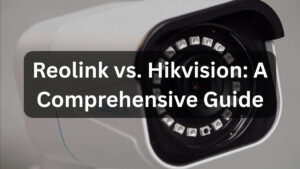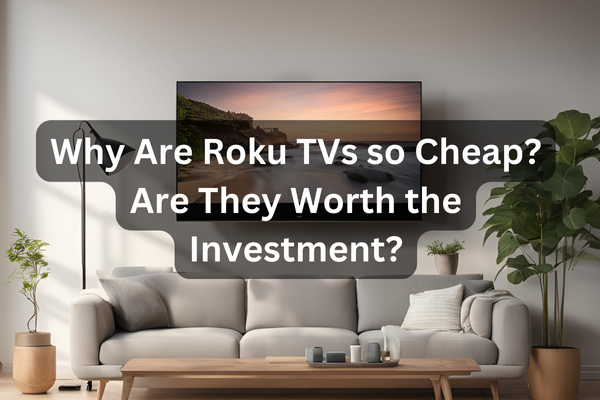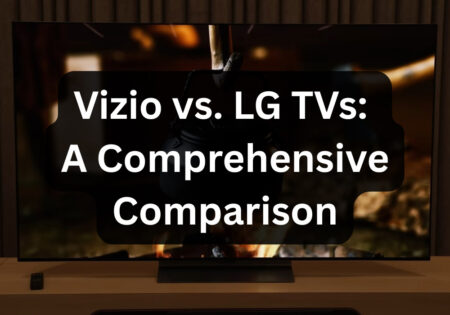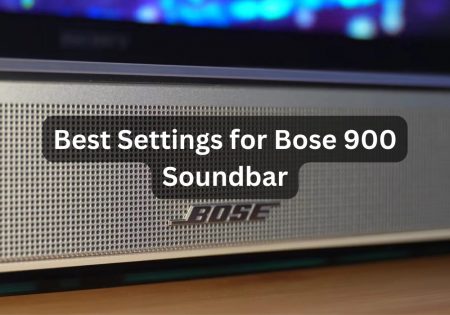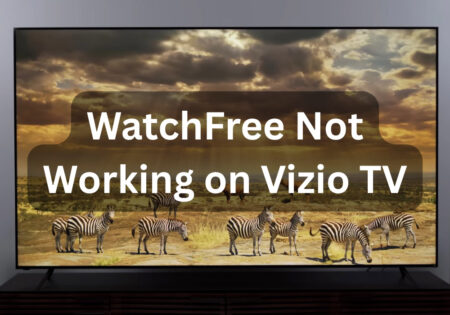Wondering why Roku TVs are so cheap? Roku has impressed everyone with its amazing streaming devices, but how about their TVs? Are Roku TVs good too? Let’s explore the secrets behind their low prices to answer the question: Why are Roku TVs so cheap? We will then thoroughly review Roku TVs, covering display technologies, audio quality, user interface, and more!
Why Are Roku TVs So Cheap?
Roku manages to introduce its TVs to the market with a low price tag. Here are the main reasons:
- Business model and strategy
- Cost-Effective Manufacturing
- Partnership with Retailers
- Focus on Essential Features
Here’s a detailed explanation of each one:

Business Model and Strategy
Roku’s cheaper TV costs can be attributed to their business style. Roku makes use of its streaming platform, in contrast to traditional TV manufacturers who mostly rely on hardware sales for revenue. They continuously generate revenue from streaming subscriptions and adverts by embedding their operating system within the TVs. Because they concentrate on generating long-term income from their ecosystem, they can sell the hardware at a lower cost.
It’s evident from my experience that Roku wants as many units installed in households as possible. They boost their advertising and subscription income and grow their user base as a result. Through this tactic, the cost of the hardware is partially covered, lowering the TVs’ price for consumers. The seamless viewing experience customers may anticipate is occasionally compromised by this emphasis on ad monetization, though.
Roku is able to defray manufacturing expenses by selling user data to advertisers and including tailored advertising. Not only does Roku employ similar tactics to subsidize its products, but numerous other Internet businesses do the same. Users will see advertisements and recommendations based on their viewing preferences even if this strategy saves money for them.
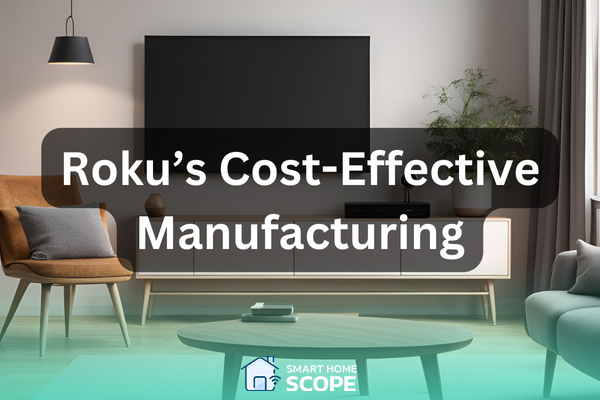
Cost-Effective Manufacturing
I’ve found Roku TVs have sturdy, dependable build quality even though it’s not premium. Without sacrificing much in terms of performance, the components are economical and purposefully designed to save costs.
Who makes Roku TVs?
In the case of Roku Select, Plus, and Pro Series TVs, the manufacturer is Roku itself. In the past, Roku used to license its Roku OS to other TV manufactures like TCL and Hisense. But recently they’ve managed to enter the market themselves, bringing their own Roku branded TVs to the market.
Roku TVs, though bereft of opulent craftsmanship, boast an enduring and steadfast fabrication.

Partnership with Retailers
Due in large part to their partnerships with big-box retailers like Walmart and Best Buy, Roku sets its prices low. Special discounts and promotions are regularly offered by these stores which help clients save money overall. These kinds of facilities also ensure high sales volumes due to the widespread availability of Roku TVs, which strengthens the company’s negotiation position with suppliers and opens up further cost-saving opportunities.
Although these alliances aid in maintaining low costs, there may be a perception problem as well. Prospective customers may have doubts about Roku TVs’ general quality and longevity in comparison to more expensive brands because they are occasionally perceived as lower-end goods that are mostly found in big-box retail settings.
Roku TV placement in busy retail spaces is a smart way to get the most visibility and sales. Retailers can also provide exclusive models and bundles thanks to these collaborations, further luring customers with discounts and special incentives that enhance the value of their purchase.
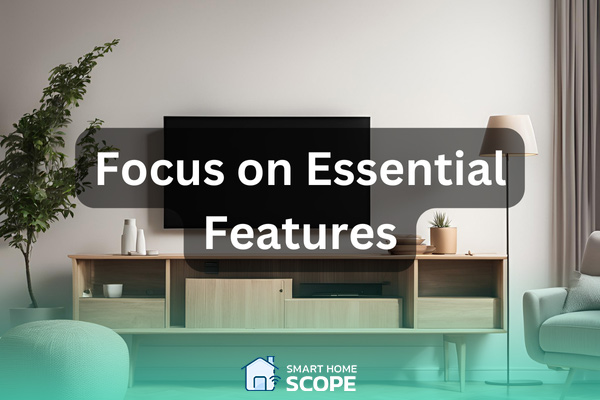
Focus on Essential Features
Instead of cramming every high-end feature under the sun, Roku TVs concentrate on the functions that matter most to their users. Prioritizing the essential components of a good viewing experience—such as a user-friendly interface, dependable performance, and respectable picture quality—allows Roku to save expenses.
Roku avoids overstuffing their TVs with cutting-edge technologies that raise prices, as I discovered when testing different models. When it comes to peak brightness, several models may fall short of more costly TVs since they employ 60Hz screens rather than 120Hz ones, even when they enable HDR. With no extraneous flourishes, our practical approach guarantees that they function well when it matters most. Power users, however, may find that this emphasis on the necessities occasionally leaves them wanting more in terms of sophisticated functionality and improved performance.
Because it doesn’t overcharge for features that a small percentage of users would find valuable, Roku ensures that its TVs meet the needs of the vast majority of its users by concentrating on basics. Through the use of this approach, they can expand their market reach and enhance their standing as a cost-effective solution.
Below, I’ve provided you with a brief review of my experience with a 55-inch Roku Select Series TV. Read this review to gain a good understanding of Roku TVs. You can then read my Onn TV review; Onn is also a brand that manufactures TVs with the Roku platform.
My Experience with the 55-inch Roku Select Series TV
Positive Feedback
From my experience using my 55-inch Roku Select Series TV, I must say that the interface is very user-friendly. The setup process is simple and intuitive, and the remote control’s simplicity makes for a positive experience straight out of the box. The ease of navigation is particularly noteworthy.
Another highlight is the excellent value for money. The TV offers a good feature set, including 4K resolution, HDR compatibility, and decent sound quality, all at a bargain price. The abundance of apps and streaming services is a major benefit, and the picture quality is more than sufficient for daily use. Additional features that enhance the experience include a large channel library and smooth integration with Roku’s ecosystem, which includes soundbars and other smart home devices.
Complaints and Issues
However, Roku TVs aren’t flawless. The advertisements on the Roku OS interface can occasionally feel invasive, which is a frequent annoyance. Furthermore, the build quality isn’t as good as higher-end brands; there have been a few minor issues with the plastic components and the remote control.
Affordability can come with disadvantages. Inexpensive models, may have performance problems. On these less expensive devices, the Roku OS can be slow, and the interface frequently freezes and needs to be rebooted. My TV’s remote control often requires a strong tap to function, and the interface can sometimes be so slow that a full reboot is necessary.
Now that you have a brief idea about Roku TVs, it’s time to dive deeper into the matter and ponder the question: Are Roku TVs good?
Detailed Analysis of Features
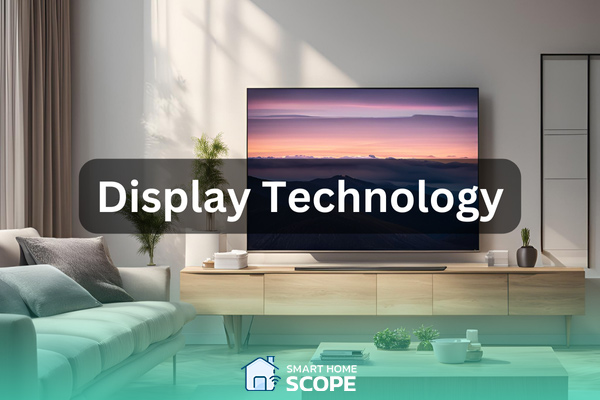
Display Technology (QLED, HDR Support)
Particularly with the Plus Series, Roku TV display technology has advanced significantly. These models have QLED displays which use a layer of quantum dots to increase color and brightness performance. This technology outperforms traditional LED displays with its precise and vivid colors.
I was impressed by Roku TVs’ QLED technology during my testing, especially considering their low cost. Rich and brilliant hues made for a delightful visual experience. It’s crucial to remember that although QLED is a big advancement, its black depths and contrast ratios still fall short of those of OLED screens. The difference is evident in darker settings, and overall contrast occasionally lacks the punch of more expensive models.
Despite the strides of QLED technology, Roku TVs’ black depths and contrast ratios remain inferior to the profound chiaroscuro of OLED screens.
Another benefit of Roku TVs is their HDR compatibility, as they support Dolby Vision, HLG, and HDR10. You may take advantage of high dynamic range information from several sources thanks to this broad range of support. Practically speaking, HDR entertainment looks fantastic on Roku TVs, with improved color representation and more clarity. Although sufficient, the peak brightness levels aren’t as high as those seen in more costly TVs. This implies that the HDR effect might not be as noticeable in really bright spaces.
Because of their dedication to providing a high-end viewing experience at an affordable price, Roku has included QLED technology and HDR compatibility into all of its higher-end models. OLED displays from rivals like LG, however, continue to have a major advantage for consumers who require the finest possible picture quality, particularly with regard to contrast and dark levels.
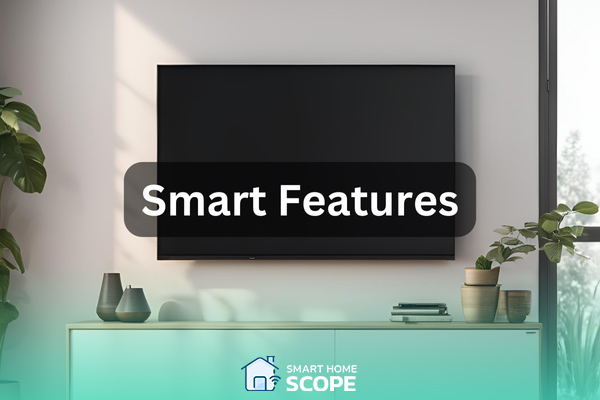
Smart Features and OS Integration
Smart features and Roku OS integration are two of Roku TVs’ greatest advantages. Easy access to a wide range of streaming services is made possible by the operating system’s intuitiveness and friendliness. One of the main reasons why so many people choose Roku over other smart TV platforms is its user-friendly interface.
I’ve found that the Roku OS is easy to use and that setting it up is not difficult. Another highlight is the remote control which has easy access buttons for well-known streaming services like Hulu, Netflix, and Disney+. There is a warning, though: some users may find it bothersome as creating a Roku account requires constant sign-ins. It’s a minor annoyance but it could turn off people who would rather use a simpler plug-and-play method.
An additional benefit is the abundance of streaming channels and apps. Roku has everything you need, regardless of your preference for specialty channels or well-known services like Netflix and Amazon Prime Video. An additional wonderful bonus offered by the Roku Channel is its selection of free programming which is financed by advertisements.
Using the remote or a linked voice assistant, users may search for material across various apps with the voice search tool which is another helpful feature. By eliminating the need to manually search through each app, this functionality improves the user experience by making it simpler to locate and watch desired content.
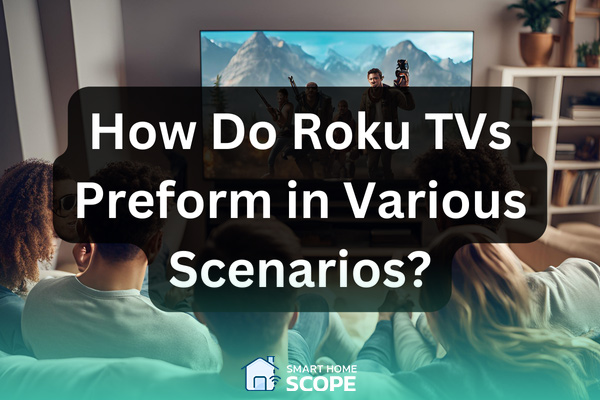
Performance in Different Use Cases (Gaming, Streaming, Regular TV Watching)
Gaming, streaming, and conventional TV watching are just a few of the use cases that must be taken into account while assessing the performance of Roku TVs. Since each use case has distinct requirements for the TV, it’s important to keep an eye on how well Roku TVs function in each one.
Are Roku TVs Good for Streaming?
Roku TVs are excellent for streaming. All of the main streaming providers are accessible through the integrated Roku OS, and dependable, lag-free streaming is provided. With a strong internet connection, I discovered that the playback was flawless even with 4K HDR video. Although the Wi-Fi performance is good, a wired Ethernet connection is advised for optimal outcomes, particularly when dealing with high-bandwidth content.
Are Roku TVs Good for Regular TV Watching?
Roku TVs perform regular TV viewing, including live TV via cable boxes or antennas, well. The live TV interface is simple to use and has good visual quality. The electronic program guide (EPG) and the ability to pause and rewind live TV using an external USB device are just two features that increase convenience.
Are Roku TVs Good for Gaming?
Roku TVs provide a passable gaming experience, but ardent gamers may not consider them first. While professional gamers may not notice the difference from higher-end TVs with advanced gaming features, the input lag is tolerable for recreational gaming. Those who need the smoothest gaming experience may find that most devices do not offer 120Hz natively. Nonetheless, the performance is more than sufficient for the majority of users and casual gamers.
For connoisseurs seeking the epitome of gaming fluidity, many Roku TVs may disappoint with their absence of native 120Hz capability.
Audio Quality
Budget TVs sometimes make compromises in the area of audio quality, but Roku has managed to produce devices with respectable sound quality. The integrated speakers have respectable bass levels and crisp conversation, making them ideal for daily watching.
The built-in speakers, however, might not be enough for an audiophile or someone who prefers a better audio experience. The audio in my tests was crisp but lacked the richness and immersion that came from using a dedicated sound system or external speakers. A home theater system or soundbar may greatly improve the audio quality of a Roku TV and make it feel more like a movie theater.
What Are the Advantages of a Roku TV?
Affordability and Value for Money
The affordability of Roku TVs is well known. There is a wide range of models to choose from, including the more sophisticated Plus Series, all at extremely cheap costs. Considering the functionality they provide, Roku TVs are an excellent value at as little as $150. They are affordable enough for a broad range of people, including families on a tight budget and college students.
When you take into account the technology built into these TVs, the value for the money is obvious. For example, the Roku Plus Series is far less expensive than comparable devices from other vendors and has 4K resolution, HDR compatibility, and quantum dot technology. Although they might not be the best TVs out there, these models function admirably, so those on a tight budget might consider them.
User-Friendly Interface
As I mentioned earlier, The Roku operating system (OS) is a big benefit of Roku TVs. Roku OS is one of the easiest to use, with a simple interface that makes it easy to browse apps and settings. The home screen is appealing with its simple and uncluttered design. The remote control has fast access buttons for popular streaming services. Roku TVs are perfect for non-techies due to their user-friendly interface and simple setup process.
Also Read:
Best Smart TVs in 2024
Wide Range of Models and Sizes
Roku offers a wide variety of models and sizes to meet various purposes. There is something for everyone, ranging from spacious 75-inch models excellent for home theaters to tiny 32-inch models ideal for smaller spaces or dorm rooms. Your search for a Roku TV that suits your needs in terms of price and space is assured thanks to this assortment.
The Roku array includes options for both main and secondary screens, so you can have a TV for your living room or bedroom. Buyers may select a TV that fits their needs precisely and within their budget thanks to the variety of models available, including HD, Full HD, and 4K UHD choices.
What Are the Disadvantages of a Roku TV?
While Roku TVs have their notable features and advantages, they’re not without flaws. Moving forward, we’ll dive deeper into these drawbacks of Roku TVs.
Limited Customization Options
While the user interface on Roku TVs is great, it can’t satisfy users who prefer to fully customize their experience. For instance, you aren’t able to change the launcher or install custom apps on your Roku TV.
Performance Issues
As mentioned earlier, Roku TVs can potentially have performance problems such as minor glitches in the interface, buffering during streaming, and possible app crashes due to their less powerful processors compared to other well-known competitors.
Privacy Concerns
Roku consistently collects data from users to personalize their experience and target advertising. Also, some channels collect data themselves, so if you’re a conscious user, you may find this a concern for your privacy.
Comparison with Competitors
Roku vs. TCL
TCL and Roku TVs have a close relationship. Both businesses benefit from this collaboration: TCL handles the hardware, while Roku supplies the software platform.
Higher-end TCL models, such as those in the 6-Series, perform marginally better than the average Roku-branded TV in terms of visual quality. This is because TCL uses cutting-edge technology including better local dimming and Mini-LED backlighting. Roku TVs are still fiercely competitive, though, particularly in the lower and mid-range markets.
Both Roku and TCL TVs using the Roku OS offer remarkably similar user experiences. The hardware specifications and construction quality are primarily where the discrepancies lie. Roku TVs are an excellent option if you want the best value. Nonetheless, TCL’s higher-end devices might be something to think about if you’re prepared to pay a little bit extra for improved features and performance.
Which is better, Samsung TV or Roku TV?
Reputed for its cutting-edge technology and superior displays, Samsung leads the TV industry. The distinctions between low-cost and high-end solutions are emphasized by contrasting Roku TVs with Samsung’s offers.
Samsung TVs have enhanced picture quality with brighter, higher contrast ratios, and more brilliant colors, notably the QLED and Neo QLED models. Samsung is a better option for gaming and high-action video because, in my tests, they also have better motion handling and upscaling capabilities.
Samsung televisions are more costly, though. Roku TVs are an attractive alternative for anyone on a tight budget. It’s possible that you can have many of the same cutting-edge features and excellent image quality for a lot less money. Roku televisions are an excellent purchase if you don’t need a home theater system and don’t mind compromising on image quality.
Another thing to think about is Samsung’s reputation for build quality and durability. Although Samsung’s premium models have a more sturdy and elegant appearance, Roku TVs are generally well-built. Although some customers may still prefer the simplicity of Roku OS, Samsung’s in-house smart TV platform, Tizen, offers a more refined experience.
Which is better, LG TV or Roku TV?
Because of its OLED technology which produces pictures with perfect blacks and infinite contrast ratios, LG is well acclaimed in the industry. The gap in picture quality between Roku TVs and LG’s OLED models is striking.
In my side-by-side assessment, LG’s OLED TVs showed superior visual quality than Roku devices in every way. The contrast was greater, the colors were more vivid, and the whole viewing experience was more engaging. WebOS from LG is another powerful smart TV platform; however, some users like Roku OS since it is more straightforward.
In my meticulous comparison, LG’s OLED TVs outshine Roku devices in every facet of visual excellence.
But LG’s OLED TVs cost a lot more. Roku offers a useful and reasonably priced substitute for individuals who don’t want to spend a lot of money on a TV. For those on a tight budget, Roku’s Plus Series is a great option because of its amazing performance considering the price.
Videophiles and those who seek the finest watching experience find LG TVs to be a great option due to their emphasis on advanced technology and superior picture quality. Nonetheless, the difference may not outweigh the increased cost for regular users and casual watchers. When it comes to getting the most for your money, Roku TVs continue to be a competitive option because of their good performance and outstanding value.
So, is it worth buying a Roku TV?
I believe Roku TVs to be a perfect choice for budget-conscious people who seek a user-friendly interface and a great streaming experience. On the other hand, some users want their TV to be premium-built, with professional picture quality and a powerful processor. For these people, I seriously do not suggest Roku TVs!
Final Thoughts
In conclusion, I can say low quality isn’t why Roku TVs are so cheap. They’ve got their tactical relationships with merchants and business strategy, so they manage to manufacture budget-friendly devices for everyone. Are Roku TVs good? I can’t say they are for everyone, but for people who want to have a good streaming experience without breaking the bank, Roku TVs are actually good.
FAQs
Is a Roku TV better than a smart TV?
It depends on your preferences. If you value affordability and want a user-friendly streaming experience, Roku TVs are a top choice. However, if you need a smart TV with extreme picture quality and a glitch-free interface, you’re better off buying a premium smart TV from Sony, LG, or Samsung.
Do you need internet to use Roku TV?
Not necessarily. You can still use your Roku TV as a regular TV with an antenna or cable, but for streaming content and using the smart features, you definitely require a reliable internet connection.
How long do Roku TVs last?
A Roku TV’s average lifespan is between 3 to 5 years, but the actual time depends on the model. Lower-end models clearly last shorter than top-tier models. Like any electronic device, your Roku TV will eventually slow down and become prone to security threats after support and updates for the model end.
Is there a monthly fee for Roku TV?
You don’t have to pay any fee after purchasing the device. However, subscribing to streaming services like Netflix, Hulu, etc., costs you fees.
Can I leave my Roku TV on all the time?
Potentially, Roku TVs can stay on all the time, but it isn’t wise to keep them on. It is advised to turn the TV off when not in use to save energy, reduce screen burn-in risk, and allow software updates to be installed smoothly.
Do I need cable if I have a Roku TV?
All you need to enjoy your Roku TV are your streaming services and a good internet connection. You still have the option to use cable, but it isn’t necessary.
